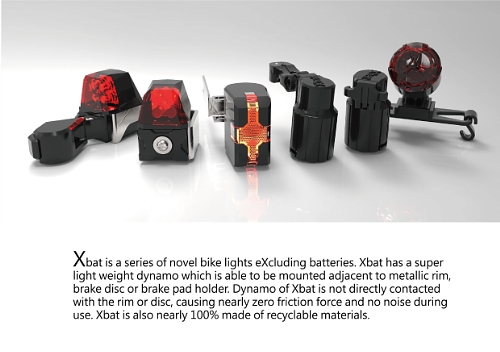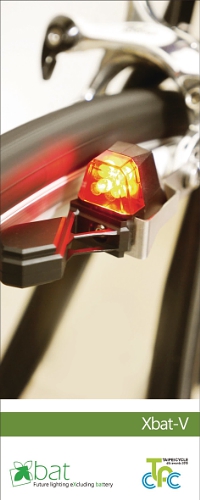Self-powered bicycle lights are nothing new. In fact, the traditional dynamo light has been around for years, and many cyclists still prefer to use dynamo-powered lights on their bikes for several reasons: these lights are always on a bike and always ready for action; as a result, there's no subsequent forgetting to put the light back on the bike, and there are no worries about the batteries unexpectedly giving out mid-ride. Dynamos, however, do have their own drawbacks. For example, friction-powered sidewall units slow a bike down and wear out a bike's tires, while dynamo hubs must be built into the wheel and add to the bike's revolving weight. In other words, dynamo lights take energy away from the momentum of the cyclist, who can feel a clear resistance when these lights are used.
Sr. Eco (Sunrise Eco-Friendly Technology) is based in Taiwan—one of the most famous bicycle centers in the world—and this company focuses on the design and production of innovative, environmentally-friendly products. Just recently, Sr. Eco launched the Xbat LED self-powered bicycle light series. These lights have caught the eye of both bicycle enthusiasts and the jury of the 2015 Taipei Cycle d&i (design and innovation) Awards. Sr. Eco's award-winning Xbat lights allow cyclists to light up their way without any loss of energy from their bikes. In specific, the Xbat's self-powered design requires no actual contact with the bike in order to create energy, unlike traditional dynamo systems.
 |
|
|
The design of the lights in the Xbat series is based on the principle of dynamic induction. Instead of employing a dynamo to generate electricity, this design takes advantage of the energy created by the passing of magnets against one another or the changes to a magnetic field whenever the wheel spins. As the wheel moves, the magnets react to the conductible rim of the bicycle wheel, or the paring magnet mounted to the bicycle, and accumulate energy, which triggers the compact generator to make the light flash. With Xbat lights, cyclists do not even feel that the bike is creating its own energy. In addition, this technology is stable and robust enough to work in all kinds of weather.
The Xbat series of lights features different models for different bicycles. The Xbat-C is designed for bicycles with a C- or V-brake, while the Xbat-D is designed for bikes with a disk brake. The Xbat-M is a tail light for road or city bikes that is designed to be fixed on a carrier or fender. In addition, integrated models are also available to meet the needs of different cyclists. In all cases, all Xbat lights automatically turn on when a bicycle is ridden, without any batteries or direct contact to the rim of a bike's tire.
A basic Xbat LED light weights only 16 grams, and its LED housing is completely waterproof. Basically speaking, Xbat lights are very compact and wireless, just like ordinary battery-powered lights. What's more, Xbat lights are good for both the environment and for cyclists. In fact, test users have been raving about Xbat lights for several reasons: cyclists no longer have to worry about changing batteries; the magnetic induction employed by Xbat lights uses only a tiny bit of the bike's momentum to generate a clear, bright light whenever a cyclist starts to peddle; Xbat lights are completely silent, unlike traditional dynamos and, best of all, Xbat lights not only look fashionable but also are very easy to mount on a bike.
Sr. Eco has also been able to overcome one of the most noticeable limitations of a traditional magnetic induction lights, namely, the gradual wavering of energy output when a spinning wheel slows downs and the complete loss of light when the wheel stops. With the Xbat-M, however, a built-in capacitor is able to keep the light going continuously for 2 to 3 minutes, even after a wheel stops spinning. This design breakthrough greatly enhances the visibility and safety of a cyclist.





 CN
TW
EN
CN
TW
EN







